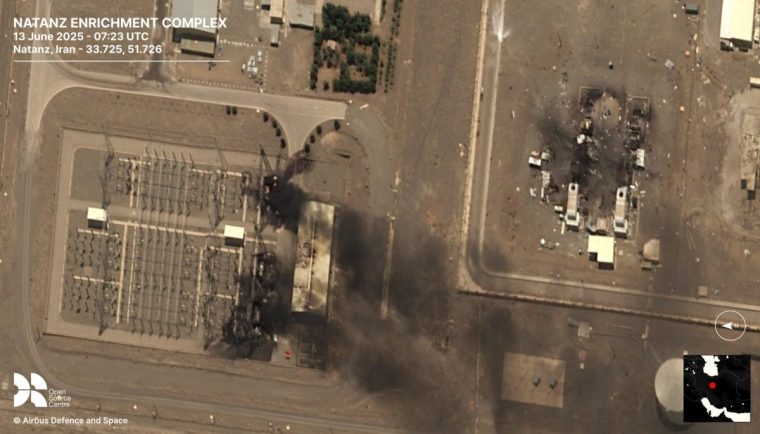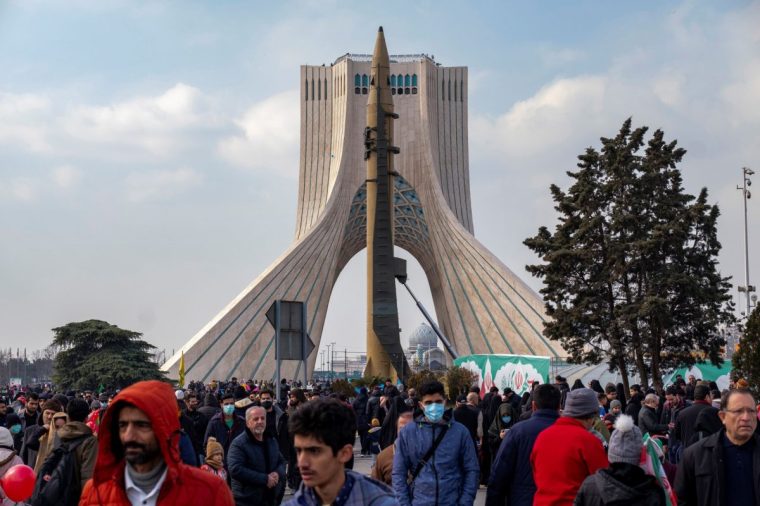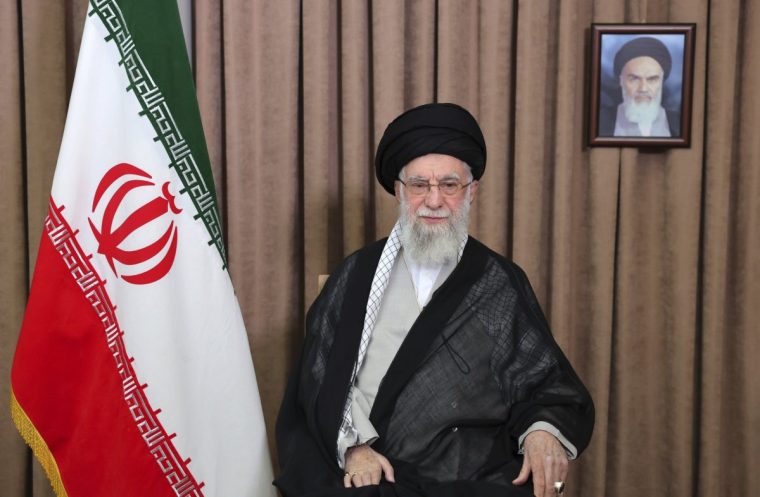Israel still has work to do if it is to destroy or significantly hamper Iran’s ability to acquire nuclear weapons, and risks emboldening Tehran into pursuing its programme to create an atom bomb at any cost, experts have warned.
The onslaught by Israeli forces against multiple Iranian targets – dubbed Operation Rising Lion – had at its core an attempt to degrade once and for all Tehran’s decades-long pursuit of a nuclear weapon, by striking both infrastructure and the scientists judged by Tel Aviv to be vital to the Islamic Republic’s atomic project.
But despite hitting the Natanz nuclear site – described by Israeli Prime Minister Benjamin Netanyahu as Iran’s “main enrichment facility” for near-weapons grade uranium, and assassinating six senior scientists, it was not immediately clear how much of Tehran’s stockpile of nuclear materials had been eliminated alongside its technical ability to build a bomb.
Leading experts, including a former UN weapons inspector and a former senior Israeli intelligence officer, told The i Paper that a number of other key Iranian installations – including Fordow, south of Tehran – needed to feature on Israel’s target list if it is to permanently hobble Iran’s nuclear project.
There were reports on Friday night that the Fordow site – where it is believed Tehran has stored a significant proportion of its uranium enriched to 60 per cent – had been struck, although the effect was unclear. The installation is deep underneath a mountain and purposely designed to be out of reach of Israel’s existing arsenal.
It may well be that Tel Aviv, which is thought to have spent at least three years preparing for Rising Lion, nonetheless has a strategy for destroying Fordow and similar sites. But experts say the operation represents a huge geopolitical gamble for Israel in which it must either succeed in neutralising Iran’s existing nuclear threat, or risk forcing the theocracy to aim once and for all at joining the ranks of nations with atomic weapons.
Iran’s atomic ‘beating heart’ hit by Israel
The Natanz nuclear facility, some 200 miles south of Tehran, is the beating heart of Iran’s atomic programme. It houses the many hundreds of centrifuges, some of them recently upgraded to highly efficient models, used to process uranium to a level where it can be turned into a nuclear warhead. This 60 per cent enriched uranium is widely regarded as the final step before proceeding to weapons-grade material enriched to a level of 90 per cent or more.
Little surprise therefore that Israel, which claimed overnight that Tehran had succeeded in enriching uranium to a level where it could make nine nuclear bombs within a year or less, made Natanz a primary target in the early hours of Friday. Israeli jets and missiles also struck the Tabriz nuclear research facility, as well as homes and dormitories occupied by research scientists.

The targeting of nuclear sites was accompanied by a carefully choreographed attempt to neutralise a significant proportion of Iran’s military leadership. This included the assassination of Hossein Salami, head of the Islamic Revolutionary Guard Corps (IRGC), the powerful branch of the military which in effect keeps the regime in place with its stranglehold on Iran’s most advanced weaponry and network of proxy enterprises.
The sheer depth of the targeting has led some to conclude Operation Rising Lion is not only about choking off Iran’s atomic project but also the leadership of the Islamic Republic itself.
Matthew Savill, a military specialist at the Royal United Services Insitute (Rusi) in London, said: “The breadth and scale of these strikes – against senior Iranian officials and other military facilities in addition to nuclear sites – suggest this operation is intended to not just dissuade Iran from pursuing nuclear weapons, but also cripple any potential military response and even to destabilise the regime.”
The targets Israel has not reached – and whether it can
Netanyahu has been clear that Friday’s strikes are likely to be merely the first instalment of what is already the largest-ever Israeli assault on its most implacable regional foe. Donald Trump appeared to give credence to the idea of an ongoing campaign when he declared “more brutal” Israeli raids are set to follow.
From an Israeli military perspective, this is probably just as well. According to leading experts, the initial salvo may have succeeded in doing not much more than delaying rather than neutralising Tehran’s nuclear programme.
David Albright, a former UN nuclear weapons inspector, said the Israeli strikes appeared to be born out of a calculation that it had to attack immediately if it was to stop Iran from entering a “crash programme” of taking the final steps to enrich uranium and build warheads within a period of a few weeks or months.
Key to such a strategy is eliminating the 60 per cent enriched uranium held by Iran, at least some of which will be housed at least 80m beneath the solid rock in which the Fordow installation is located. Failure to reach these stocks will give Tehran little reason not to accelerate to the final stage of its nuclear project, it is claimed.
Albright – founder of the Institute for Science and International Security, which monitors nuclear proliferation – said: “If Israel doesn’t get to the 60 per cent [stocks], if they don’t put Fordow out of action, then I would imagine Iran will enrich to weapon grade. I mean, why not? I assume they [Israel] have got something planned for the 60 per cent stock.
“It’s up to Israel to stop Iran from succeeding if they move to a crash programme, but how they’ll do that, I don’t really know.”
Such uncertainty betrays what appears to be the one obvious faultline in Operation Rising Lion – the suspicion Israel lacks the munitions it would need to put Fordow, or similarly protected installations, beyond use. It has previously been reported that the Israeli air force possesses weapons which are capable of causing cave-ins at the entrance and surface levels of Fordow, but may not be able to cause deep internal damage.
In the West, such “bunker-buster” bombs remain the sole purview of the American military, which has designed weapons such as the 30,000lb MOP, or massive ordnance penetrator, with the purpose of being able to destroy targets hidden within the natural defences of a mountainside.
A leading Israeli expert suggested American help may yet be required for Operation Rising Lion to achieve its aims.
Brigadier General Yossi Kuperwasser, a former senior Israeli military intelligence officer and head of the Jerusalem Institute for Strategy, a hawkish think-tank, said: “There’s still significant work ahead and I hope the Americans will join the effort.”
There is, as yet, no evidence such intervention from the Trump administration, whose relations with the Netanyahu government have been strained of late, will be forthcoming. But such is the volatility of the situation unleashed by Rising Lion that few scenarios can be ruled out.
Kuperwasser said a succession of key Iranian sites remained to be targeted, including a uranium conversion facility in the city of Isfahan, which he said if destroyed could cripple Iran’s ability to revive its nuclear programme.

He said other targets which appeared untouched so far included enriched uranium storage sites, centrifuge production plants, factories for producing unrefined “yellowcake” uranium ore, and complexes involved in producing metals and explosives for nuclear weapons.
An added complication for Israel is the sheer ability of Iran to move its nuclear material around a country which has long prepared for an attack similar to that unleashed in the last 48 hours.
Albright said even obvious targets such as Natanz had underground sites which would be difficult for Israeli strikes to reach, and Iran had a proven record of moving its uranium stocks to multiple sites, leaving Tel Aviv facing a complex game of nuclear whack-a-mole.
Albright said: “Iran may be trucking around its 60 per cent [uranium] right now.”
How Iran can respond – and the fear of a wider war
Despite Tehran declaring Israel’s attack to amount to a “declaration of war”, there is something close to an optimistic scenario for the evolution of what is one of the most perilous escalations of conflict in the Middle East since the Second World War.
It may be that an Iranian regime, already considerably weakened by a year of confrontations with Israel and the West which has seen its proxy militias such as Hezbollah and Hamas seriously degraded, will choose to embrace a path towards de-escalation, if convinced that its very survival is in question.
Such a diplomatic “off-ramp” could even come as soon as this weekend if Tehran decides to continue planned negotiations on a nuclear deal with an American delegation in Oman on Sunday, although Iranian state media reported on Friday that such talks had been postponed indefinitely.

Albright said: “Maybe [Iran] will just take the hit and Iran will essentially have its nuclear enrichment programme ended, and maybe there can even be negotiations picked up. It seems unlikely, but that’s one possible outcome. Perhaps Israel will pursue its targets, Iran doesn’t overly react, and then they can have negotiations.”
However, experts, including Albright, acknowledge that an equally plausible – if not probable – outcome is one of a redoubling by Iran of its efforts towards harnessing atomic science to build a nuclear bomb.
There was immediate concern in Western capitals that alongside the suite of retaliations available to Tehran – ranging from cyber attacks to ordering proxy forces such as Yemen’s Houthis into action – it will also conclude it has no reason not to take the final steps towards nuclear weapons, if it is able to do so.
Such a move could spark a geopolitical chain reaction with other regional powers, in particular Saudi Arabia and Turkey, concluding that they too need the ultimate weapon.
Darya Dolzikova, a nuclear proliferation specialist at Rusi, said: “The concern is whether these attacks finally convince Iran it has no choice but to develop a nuclear weapon as the ultimate deterrent and whether Israel has done sufficient damage to prevent Iran from being able to act on such a decision.”
A key step on this path is likely to see Iran announce it is withdrawing from the Nuclear Non-Proliferation Treaty (NPT), the international agreement designed to act as a bulwark against the club of nuclear powers expanding beyond the nine countries – including Israel – known to possess the atom bomb.

Such a move, which Tehran has previously threatened to make, would take Iran beyond the auspices of the International Atomic Energy Agency (IAEA), the UN body which for now at least has a role in monitoring Iran’s nuclear activities and alerting the outside world – as it did on the eve of the Israeli strikes – when it is no longer compliant with its undertakings.
Dolzikova said: “Should Iran decide to [withdraw from the NPT], its nuclear programme will become a much more challenging nuclear proliferation threat to deal with than it is now.”
The result is a moment of rare and potent peril for the Middle East and indeed the wider world. As a former senior Nato official put it: “We have feared this moment for a long time. And the reason we feared it is precisely because the potential outcomes are so varied and so close to the sort of uncontrolled escalation that can lead to a regional war, or worse.”
